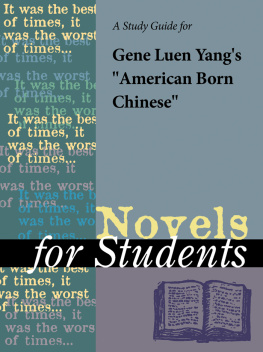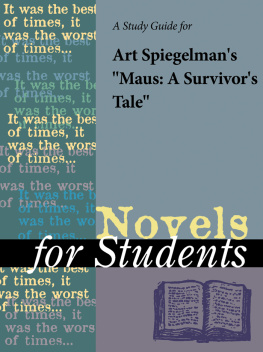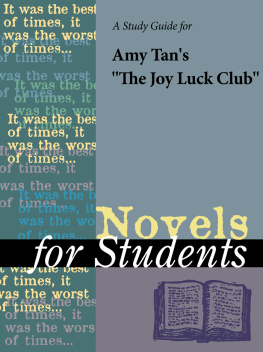TABLE OF CONTENTS
Guide
Novels for Students, Volume 39
Project Editor: Sara Constantakis
Rights Acquisition and Management: Margaret Chamberlain-Gaston, Jacqueline Flowers
Composition: Evi Abou-El-Seoud
Manufacturing: Rhonda Dover
Imaging: John Watkins
Product Design: Pamela A. E. Galbreath, Jennifer Wahi
Content Conversion: Katrina Coach
Product Manager: Meggin Condino
2012 Gale, Cengage Learning
ALL RIGHTS RESERVED. No part of this work covered by the copyright herein may be reproduced, transmitted, stored, or used in any form or by any means graphic, electronic, or mechanical, including but not limited to photocopying, recording, scanning, digitizing, taping, Web distribution, information networks, or information storage and retrieval systems, except as permitted under Section 107 or 108 of the 1976 United States Copyright Act, without the prior written permission of the publisher.
Since this page cannot legibly accommodate all copyright notices, the acknowledgments constitute an extension of the copyright notice.
For product information and technology assistance, contact us at Gale Customer Support, 1-800-877-4253.
For permission to use material from this text or product, submit all requests online at www.cengage.com/permissions.
Further permissions questions can be emailed to permissionrequest@cengage.com
While every effort has been made to ensure the reliability of the information presented in this publication, Gale, a part of Cengage Learning, does not guarantee the accuracy of the data contained herein. Gale accepts no payment for listing; and inclusion in the publication of any organization, agency, institution, publication, service, or individual does not imply endorsement of the editors or publisher. Errors brought to the attention of the publisher and verified to the satisfaction of the publisher will be corrected in future editions.
Gale
27500 Drake Rd.
Farmington Hills, MI, 48331-3535
ISBN-13: 978-1-4144-6702-3
ISBN-10: 1-4144-6702-8
ISSN 1094-3552
This title is also available as an e-book.
ISBN-13: 978-1-4144-7368-0
ISBN-10: 1-4144-7368-0
Contact your Gale, a part of Cengage Learning sales representative for ordering information.
Printed in Mexico
1 2 3 4 5 6 7 16 15 14 13 12
American Born Chinese
Gene Luen Yang
2006
Introduction
Gene Luen Yang's graphic novel, American Born Chinese, was originally serialized online on Modern Tales.com. First Second Books published the complete story in print in 2006. American Born Chinese has the distinction of being the first graphic novel to receive the Michael L. Printz Award and was the first graphic novel to be nominated for the National Book Award. The full text is no longer available online. Yang, however, does provide a preview on his home page (http://geneyang.com/american-born-chinese).
American Born Chinese contains three seemingly unrelated narratives that are creatively linked together in the end. The book begins with an account of the Monkey King, a traditional Chinese folktale. It then details the life of Jin Wang, a Chinese American boy who moves to a predominately Caucasian suburb. The final story concerns the Caucasian American Danny and his cousin Chin-Kee. Chin-Kee is a negative Asian stereotype who makes life difficult for his cousin. Each thread of the graphic novel is drawn into an exciting conclusion that explores themes of self-identity and self-acceptance.
Author Biography
Yang was born in Alameda, California, in 1973. Yang describes his childhood in the California suburb of Saratoga as complex in his Kartika Review interview with Sunny Woan. He saw Saratoga gradually shift from a predominately Caucasian population into a diverse neighborhood that came to include people and cultures from around the globe. The child of Asian immigrants, Yang grew up listening to traditional stories from China such as the Monkey King, which he later included in his graphic novel. He graduated from the University of California at Berkeley with a degree in computer science and a minor in creative writing.
Yang began drawing comics while he was in elementary school. Yang created Humble Comics in 1996 as a vehicle to publish his work. In 1997, he won a Xeric grant to create Gordon Yamamoto and the King of the Geeks. Yang has created comics with different themes over the years, including The Rosary Comic Book, which incorporates religious themes that reflect the artist's personal beliefs. Many of his other comics are more fantasy-based. Yang self-published some of his early work and serialized other stories, including American Born Chinese, online.
The print publication of American Born Chinese in its entirety in 2006 brought the author mainstream popularity as he addressed the issues of multiculturalism, assimilation, and identity. He followed this success with a 2009 collaboration with Derek Kirk Kim, The Eternal Smile. Yang published Prime Baby in 2010 and worked with Thien Pham on the 2011 comic Level Up. Several of Yang's comic tales have received the Eisner Award, which is considered the Academy Award for American comic writers.
As of 2011, Yang lived in Fremont, California, with his wife and children. When he was not creating comics, Yang teaches computer science at the Catholic high school Bishop OLaDowd in Oakland, California. He is also a strong supporter of using comics in education.
Plot Summary
American Born Chinese is a multi-narrative work that develops the three distinct stories of the Monkey King, Jin Wang, and Danny and Chin-Kee. Yang unites these stories at the conclusion. The three narratives are broken into different sections of the book that resemble chapters. As a graphic novel, American Born Chinese tells the stories using sequential art.
Media Adaptations
- Yang explains the concepts behind American Born Chinese in a YouTube video posted by the America.gov Web site on June 4, 2009.
- Yang discusses his work in a lecture at the University of California Berkley at the Story Hour in the Library Web site (http://wn.com/Story_Hour_in_the_Library__Gene_Yang).
Individual pictures or panels are created to depict moments. The panels are placed in sequence to drive the action of the story, and the text supports the graphics. The square boxes hold narrative text, and the balloons have dialogue or thoughts. The text is written in capital letters so that it is easier to read. A page featuring a character's picture introduces his chapter of the book.
Monkey King
This multi-narrative story begins with the modern retelling of the Monkey King, a centuries-old Chinese fable. The first scene is told by an omniscient narrator and describes a banquet of the gods in heaven. The Monkey King smells the food and becomes hungry. Born out of a rock, he is a Deity in his own right and rules the monkeys on Flower-Fruit Mountain. He has also mastered Kung-Fu and the four heavenly disciplines to become immortal. The Monkey King decides he should attend the banquet of the gods in heaven because he is a deity. The gods, however, refuse to associate with him because he is a monkey and does not wear shoes. The Monkey King is insulted and forced to leave. In retaliation, he attacks the guests at the party. When he returns to Flower-Fruit Mountain, however, he feels ashamed of being a monkey. The anger and shame he feels as a result of the rejection of the other gods will affect his future actions.






















